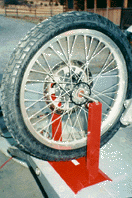Okay,
you now have a mounted tire and you are ready to balance your wheels. There are two ways to balance a wheel; bubble
balance and spin balance. A bubble balancer is simple device that has a spindle that goes through the axle opening
and has a bubble on the end. I have seen bubble balances that hang from the ceiling and ones that have a stand.
I have never used one of these, but assume that would be an adequate way of  balancing a tire. A spin balance consists of a stand and axle set that allows
you to set the wheel in the stand and spin it. The stand I use is made by Telefix and is sold through Spec II,
818-504-6364. Spec II also sells strips of self-adhesive weights necessary to balance wheels. The stand itself
comes with a good variety of axle diameters. Before you begin to balance your wheel, it is important to do a little
prep work. First, make sure your tire is inflated to the proper pressure and the valve cap is on the valve stem.
Next remove all of the existing weights from the wheel. If the weights are the self adhesive ones, you should remove
as much of the foam-adhesive as possible. If the weights are clamped to the spokes, gently spread them apart and
slip them off the spokes. Next you will need to clean the tire and wheel thoroughly. Remove the paper tire labels
and the adhesive residue from the rim of the wheel, using acetone or denatured alcohol. Make sure that there are
no clumps of mud or any other large deposits of dirt and gunk on the wheel and tire. Find the appropriate axle
for your wheel and run it through the wheel and place the wheel on the stand. Give the wheel a healthy spin and
eyeball the wheel for any wobble. If the wheel appears to be true, stop it from spinning and then give it a gentle
spin which will make it rotate several times. The wheel will eventually stop with its heaviest area at the bottom,
usually the valve stem. Snip a segment from the weight strip and secure it to the rim with a small piece of duct
tape. Now rotate the wheel about half a turn and see if it swings back to the heaviest spot. Rotate the axel back
and forth until the wheel settles with its heavy spot down. Add weight until you can rotate the wheel and it does
not rotate any more on its own. This will require cutting some of the weights into smaller segments. Once you have
the wheel to the point where it does not rotate on its own, you are ready to fix the weights to the rim. Remove
the backing and stick the weights to the clean rim, applying the weights to both side of the rim to keep the weight
in the general area. Place a strip of duct tape over the weights to ensure that they do not fly off. You are done!
Re-mount the wheel.
balancing a tire. A spin balance consists of a stand and axle set that allows
you to set the wheel in the stand and spin it. The stand I use is made by Telefix and is sold through Spec II,
818-504-6364. Spec II also sells strips of self-adhesive weights necessary to balance wheels. The stand itself
comes with a good variety of axle diameters. Before you begin to balance your wheel, it is important to do a little
prep work. First, make sure your tire is inflated to the proper pressure and the valve cap is on the valve stem.
Next remove all of the existing weights from the wheel. If the weights are the self adhesive ones, you should remove
as much of the foam-adhesive as possible. If the weights are clamped to the spokes, gently spread them apart and
slip them off the spokes. Next you will need to clean the tire and wheel thoroughly. Remove the paper tire labels
and the adhesive residue from the rim of the wheel, using acetone or denatured alcohol. Make sure that there are
no clumps of mud or any other large deposits of dirt and gunk on the wheel and tire. Find the appropriate axle
for your wheel and run it through the wheel and place the wheel on the stand. Give the wheel a healthy spin and
eyeball the wheel for any wobble. If the wheel appears to be true, stop it from spinning and then give it a gentle
spin which will make it rotate several times. The wheel will eventually stop with its heaviest area at the bottom,
usually the valve stem. Snip a segment from the weight strip and secure it to the rim with a small piece of duct
tape. Now rotate the wheel about half a turn and see if it swings back to the heaviest spot. Rotate the axel back
and forth until the wheel settles with its heavy spot down. Add weight until you can rotate the wheel and it does
not rotate any more on its own. This will require cutting some of the weights into smaller segments. Once you have
the wheel to the point where it does not rotate on its own, you are ready to fix the weights to the rim. Remove
the backing and stick the weights to the clean rim, applying the weights to both side of the rim to keep the weight
in the general area. Place a strip of duct tape over the weights to ensure that they do not fly off. You are done!
Re-mount the wheel.